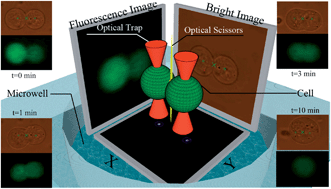A microengineered cell fusion approach with combined optical tweezers and microwell array technologies†
Abstract
Cell fusion in vitro can be artificially achieved through microengineering technology. This paper presents a laser-induced cell fusion methodology on the microwell array-based microfluidic chip, with high selectivity and controllability at the single cell level. Optical tweezers and optical scissors are employed to achieve cell pairing and fusion, respectively. The specific cells are first characterized with high spatio-temporal resolution and preselected from the mixture through an on-chip isolation method prior to pairing. The paired cells are then transported, deposited, fused, and released at the desired location with high controllability. Biophysical analysis on the fused cells shows that the fusion efficiency of the homotypical pairs is higher than that of the heterogenic pairs obtained based on different combinations of sample cells, such as human embryonic stem cells and Jurkat cells. This laser-induced cell fusion technique offers a new opportunity to explore specific targeted therapy in stem cell research for the treatment of human diseases.


 Please wait while we load your content...
Please wait while we load your content...